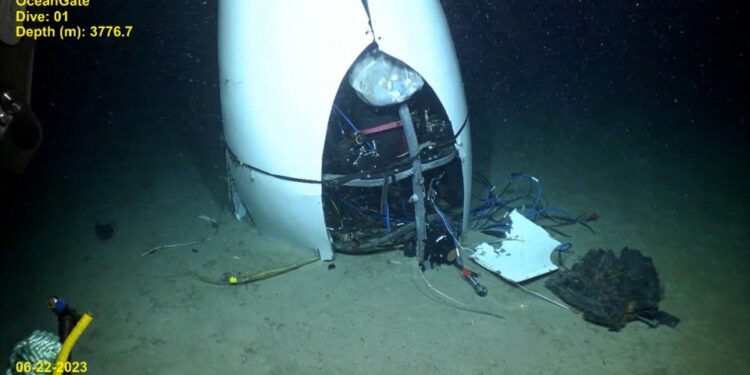A TRAGIC map has revealed how the doomed Titan sub came agonisingly close to reaching the Titanic wreck before it imploded in the depths of the Atlantic.
The submersible’s debris was dispersed over an area of around 322,917 square feet – the equivalent of almost six football fields – on the sea bed after disaster struck in June 2023.
As part of the continuing Marine Board of Investigation (MBI) hearings, the US Coast Guard on Tuesday released the mapped locations of the debris on the North Atlantic Ocean’s seafloor.
Turns out the doomed sub was just 1,600ft away from the Titanic’s bow before its fatal implosion claimed the lives of five passengers as they descended to the iconic wreckage.
The Coast Guard source told Popular Science that the photographs identify the precise positions of the submersible wreck.
The National Transportation Safety Board (NTSB) engineer is expected to give evidence before the Coast Guard today as part of the ongoing inquiry into last year’s horror.
Read more on the Titan Sub
A public hearing was held earlier this month by the Coast Guard as a part of a high-level probe into the reason behind the implosion.
Part of the testimony has been on the company’s problematic history as well as a number of unsettling videos and pictures that the MBI has recently made public.
Visual re-creation earlier in the hearing revealed that “all good here” was one of the final messages delivered by Titan’s crew to support ship Polar Prince before the submersible imploded.
The support vessel then sent repeated messages asking if Titan could still see the ship on its onboard display.
Rescuers hurried ships, aircraft, and other equipment to an area about 435 miles (700 kilometres) south of St. John’s, Newfoundland, when the submersible was reported overdue.
Titan’s wreckage was then discovered approximately 330 yards (300 meters) off the Titanic’s bow, according to Coast Guard officers.]
All five on board – including OceanGate’s founder Stockton Rush, Brit billionaire Hamish Harding, 58, French Titanic expert Paul-Henri Nargeolet, 77, Brit-Pakistani businessman Shahzada Dawood, 48, and his 19-year-old son Suleman – died during the expedition.
As part of the investigation into the tragedy, chilling new footage of a deep-sea salvage mission to recover the wreckage of the lost Titan submersible was made public on Monday.
On June 26 of last year, a remotely operated vehicle can be seen in the footage tying heavy yellow ropes and equipment to what looks to be the end cap of the sunken vessel.
The vehicle lifted off the sea bed around 2.5 miles below the surface of the North Atlantic Ocean, as drone footage later revealed a dusty cloud bursting on the ocean floor.
Several additional witnesses, some of whom had strong ties to the corporation, are expected to testify during the MBI hearing, which is scheduled to continue through Friday.
Don Kramer, an engineer, William Kohnen of Hydrospace Group Inc., and Bart Kemper of Kemper Engineering are among the witnesses slated to speak on Wednesday.
Former OceanGate operations director David Lochridge testified earlier in the trial that he had regular disagreements with the company’s CEO, Stockton Rush, who perished in the implosion, and believed the company’s main goal was to maximise profits.
Mr Lochridge said: “The whole idea behind the company was to make money. There was very little in the way of science.”
Mr Lochridge and other former witnesses presented an image of a business eager to get its unusually constructed vessel into the water.
The disaster went to spark a global discussion concerning the future of private undersea exploration.
Businessman Guillermo Sohnlein quit OceanGate prior to the Titan tragedy, despite having co-founded the company with Stockton Rush.
He told the Coast Guard panel on Monday his hope that the tragedy may spur a silver lining by creating new interest in exploration, including in the world’s deepest ocean regions.
The co-founder said: “This can’t be the end of deep ocean exploration. This can’t be the end of deep-diving submersibles and I don’t believe that it will be.”
At the beginning of the hearing, Coast Guard representatives also pointed out that, contrary to customary procedure, the submersible had not undergone an independent review.
They also mentioned how the undersea exploration community scrutinised the Titan because of its unique design.
The submersible had been visiting the Titanic’s wreckage since 2021.
Following the horror implosion, Washington-based OceanGate ceased operations.
Although the company does not currently have any full-time workers, it was represented by an attorney during the hearing.
Since the start of the Coast Guard and NTSB investigations, the business stated it has cooperated fully with authorities.














